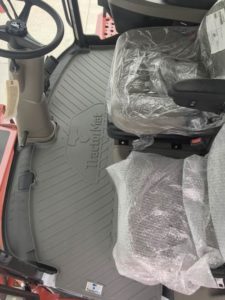16 nifty retrofit items to fine-tune your combine
The internet is awash with bolt on bits of technology to improve your combine’s harvesting performance.
We’ve picked out some handy items used by farmers all over the globe – some help establish crops right behind the combine, others deal with chaff to reduce weed seed problems further down the line.
There are even groovy extras such as coffee holders and floor mats that make life in the saddle just a little more comfortable.
1. Autocast
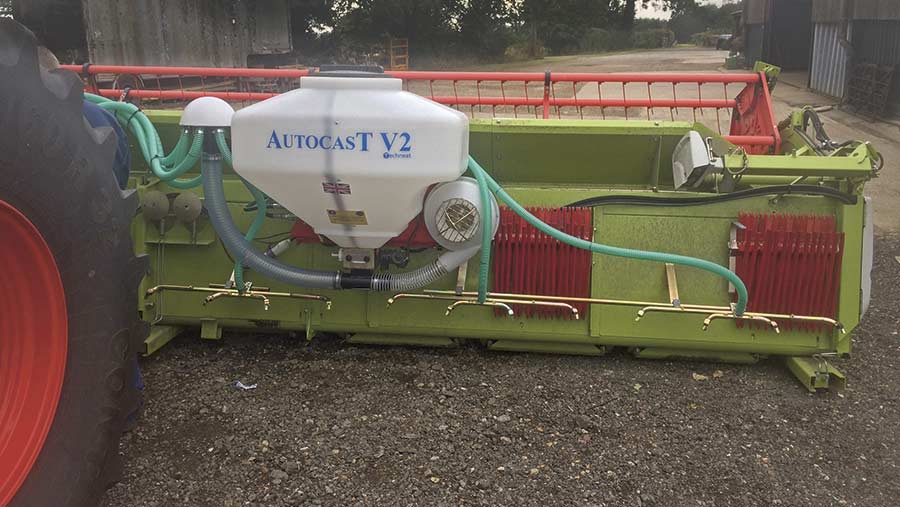
Originally developed by Cambridgeshire farmer Michael Godfrey, the Autocast system has been sold by Littleport-based engineering firm Techneat since 1997 and it has had a small resurgence recently.
Back in its heyday Techneat was shifting more than 100 of the landwheel-driven seeding units each year, and in 2007 it got a revamp to its current guise – the Autocast V2.
The Autocast’s 200-litre split hopper is mounted on the back of the combine header and spreads seed across the swath width as the previous crop is cut, then covers it with a layer of chopped straw.
See also: Articulating Tribine combine is king of the US harvest
Its most common use is for cost-effective oilseed rape establishment, with the option to mix in slug pellets where necessary, but rising use of cover crops has increased interest again. The V2 can also be adapted to apply Avadex granules, helping to maximise its use beyond auto-casting seed at harvest.
Techneat now offers GPS rate control and the option of a hydraulic fan for headers over 25ft. The seeder has successfully spread to 40ft.
Prices start at about £5,600 for a unit, which includes GPS, hopper, lever sensor, seed-flow detection and auto work switch. The firm also offers a full fitting service at extra cost.
2. Glenvar Bale Direct
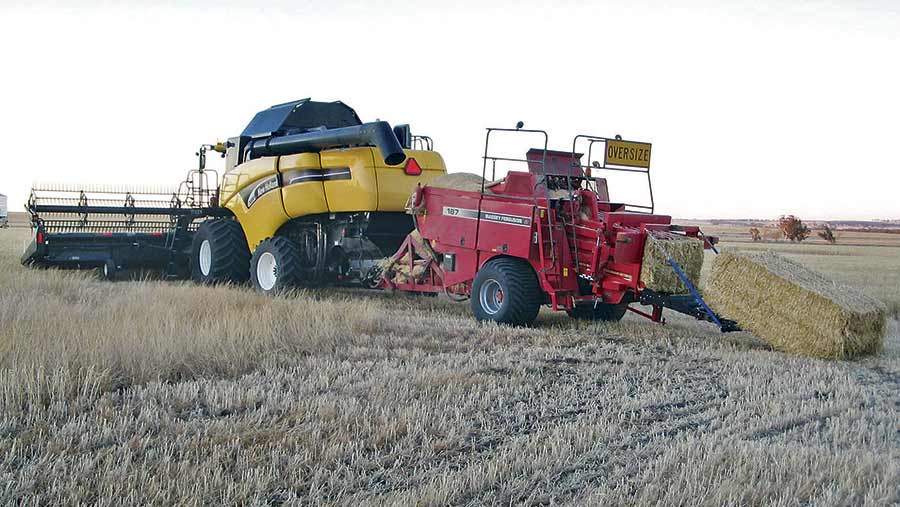
Perth-based Australian company Glenvar saw the opportunity to improve harvest efficiency by attaching a baler straight onto the combine, and came up with its Bale Direct System.
The bolt-on kit marries a big square baler to the back of the combine via a drawbar fixed to the front drive axle and uses an independent hydraulic motor to drive the baler instead of a pto.
As the system directs all crop residue straight into the front of the baler, it picks up 30% more straw than running a separate machine and bales are clean and uncontaminated.
It also snaffles up 98% of weed seeds, which has been a big attraction for Aussie growers with herbicide-resistant ryegrass problems, preventing seed return and negating the need for straw burning.
The system is yet to be tried in denser European crops, but has proved itself on the prairies of North America and across Australia’s grain belts over several years, and can be adapted to suit most major combine and baler brands.
3. Single Pass Round Bale
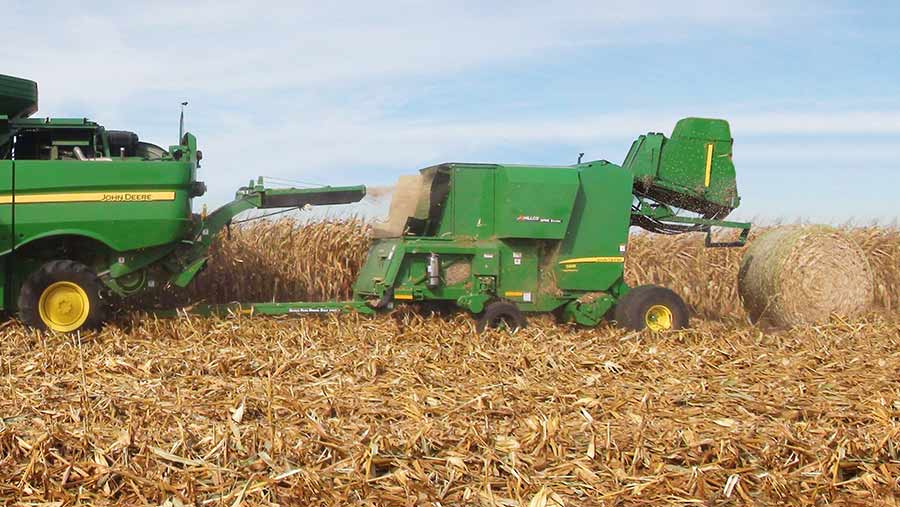
US-based Hillco Technologies offer a system that allows owners of S-Series John Deere combines with ProDrive transmission to harvest grain and round bale crop residue in one pass.
The Single Pass Round Bale System hitches on to the back of the harvester on a tow ball, and a chute plumbed into the chopper system fires material into an accumulator.
Once the accumulator has enough to make a bale, it starts to feed a John Deere 569 baler linked to the back and allows non-stop operation, with no need to pause to empty the bale chamber.
A hydrostatic drive powers the unit and sucks up to 70hp from the combine.
Originally designed for collecting what US farmers call “corn MOG” (material other than grain) for use in feedlots, it has also been tested in smaller-grained crops and soybean.
Rough pricing on the SPRB System is US$112,000 (£83,000), which does not include the John Deere 569 Round Baler.
4. Combine cameras

Combines can be ungainly things to operate, and installing a camera or multiple cameras to monitor performance or eliminate blind spots can significantly cut driver stress during long days in the seat.
Chris Baldwin of Ramsgate-based Reversing Cameras UK says popular camera spots are on the rear end, unloading auger and each flank for going through tight spots such as gateways.
One placed on top of the grain tank is also useful to monitor grain level, as well as look out for low-hanging branches on headlands. Some have even installed them in the guts of the machine to keep an eye out for blockages.
Cameras and monitors are two a penny these days, with vast numbers on eBay and Amazon, but Mr Baldwin advises farmers to spend a little bit more to get reliable equipment that lasts in what is a harsh environment.
Most opt for fully waterproof wired systems over wireless because they are powered directly from the in-cab monitor, plus cables need to be run to wireless cameras anyway, so require no less faff.
CCD (charged-coupled device) cameras will give better resolution, colour and low-light performance than cheaper CMOS (complementary metal-oxide-semiconductor) versions.
A monitor and single CCD camera plus wiring costs about £150. Those wanting a more comprehensive view can pick up a four-way split screen monitor, four cameras and wiring for between £380 and £410, depending on whether you go for a 7in or 10in screen.
5. LED lights
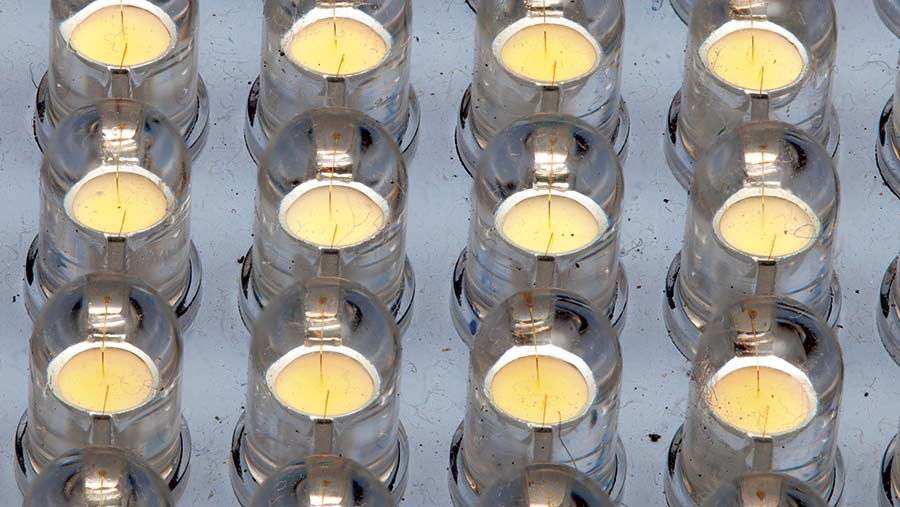
© ING Images
Anyone that has driven a big combine at night will tell you decent work lights are a godsend, and retrofitting high-output LEDs can boost night-time visibility around the machine.
Halogen lights are poor for illuminating long distances and produce a “dirtier” light with an orangey hue, while LEDs produce a whiter light more akin to daylight.
If considering the switch to LEDs, Graham Smith of Newark-based Retrofit Parts says buyers should beware of poor-quality products that don’t kick out as much high-quality light.
An LED light’s power is described in theoretical and actual lumens (measure of light visible to the human eye).
Cheaper versions from China will often tout a high theoretical lumens figure to entice customers to buy, but the critical figure is the actual lumens rating.
An EMC (electromagnetic compatibility) rating is also essential to ensure that the lights don’t interfere with radios and other electronic devices on the machine after fitment and a good IP69 rating will ensure it is water and dust proof.
Retrofit Parts sell Finnish-made Nordic Lights and for combines, Mr Smith says, the most popular set up is to mount a 24w light on the unloading auger and the rear of the machine – both particularly beneficial when combined with cameras.
In addition, two 50w units on the front hand railings will flood the driver’s view, and on Claas and John Deere machines this can be done simply by unplugging existing halogen units and replacing them with LEDs.
If opting for Nordic’s N-Series, lenses are interchangeable and offer flood and spot versions, depending on preference or operation if shifting them between machines.
The 24w units cost £55 each, while the 50w retails around £165. The company also offers a cheaper KL-Series for the more budget conscious. Other reputable brands include Grote, Hella, JW Speaker and Tyri.
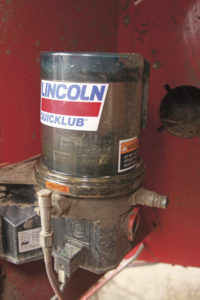
6. Auto lube systems
Getting to the most awkward grease nipples and delivering the right amount of grease at the right interval can be a chore on any machine, but around combines perhaps more so.
They are expensive, too, so should be regularly maintained to prevent wear and tear and keep up resale value. That’s where an auto lube system can help.
Providing lubrication to bearings and linkages as the machine is in use at preset intervals, advocates say, is the most efficient way to lubricate and uses grease or oil efficiently.
A SKF Lincoln-branded 24v electric-powered P203 grease pump with a 2kg reservoir is man enough for most combines, and along with divider valves and pipework for six grease points costs about £1,100.
This will increase as more grease points are added.
7. Flexxifinger crop lifters
Based in Assiniboia, Saskatchewan, Canadian company Flexxifinger offers a huge range of crop lifters designed to make picking up short or flat crops much easier.
The firm’s major selling point is its patented quick detach system. A “QD” nut is attached to the knife guard and the lifter’s spring mechanism snaps into place when fitting.
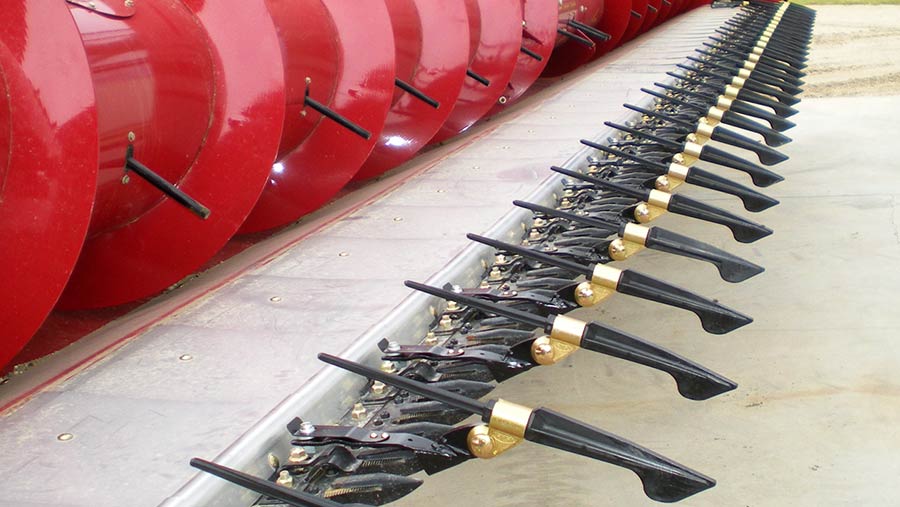
The spring is simply pushed down and the lifter pulled off for removal, saving bundles of time when switching between crops.
While most of Flexxifinger’s lifter portfolio is more suited to North American conditions, three models will appeal to UK operations.
Made of cast metal, the FlexxiFloat 250 is suited to taller and denser European cereal crops and is said to stand up to the toughest ground conditions.
The Heavy Duty crop lifter is a similar concept, but has a nylon lifting finger, while the DFO is specifically designed for auger headers widely used in the UK.
Prices are between €54 (£48) and €72 (£64) for the lifters and can be delivered to the UK from Flexxifinger’s European warehouse in Germany.
For more info visit the Flexxifinger website, where they have a neat “Find your crop lifter” tool to help potential customers select the right tool for the job based on crop and soil conditions.
8. TractorMat
US company TractorMat supply custom-fitted floor mats made from high-grade, durable plastic for a range of John Deere, Case IH and New Holland machines, including combines.
If you are going to be spending 100 hours a week in a cab, it’s good to keep it clean and it won’t do the resale value any harm either.
Flexible and easy to install, the mat prevents excess wear in the original floor and a high lip around its edge contains dirt and spills. It can then be quickly removed and pressure washed clean.
For keen buyers, a customised logo can be moulded in on request.
A single mat for a range of Deere, Case or New Holland models costs about US$175 (£130) plus shipping.
9. OXX Coffeeboxx
The OXX Coffeeboxx claims to be able to deliver fresh filter coffee in the most rugged environments and is ideal for long nights on the combine.
The all-in-one portable machine weighs just 5kg and runs off the mains, so with an inverter could easily sit in the cab and provide the driver with fresh coffee – waving goodbye to stale and lukewarm brews from a Thermos.
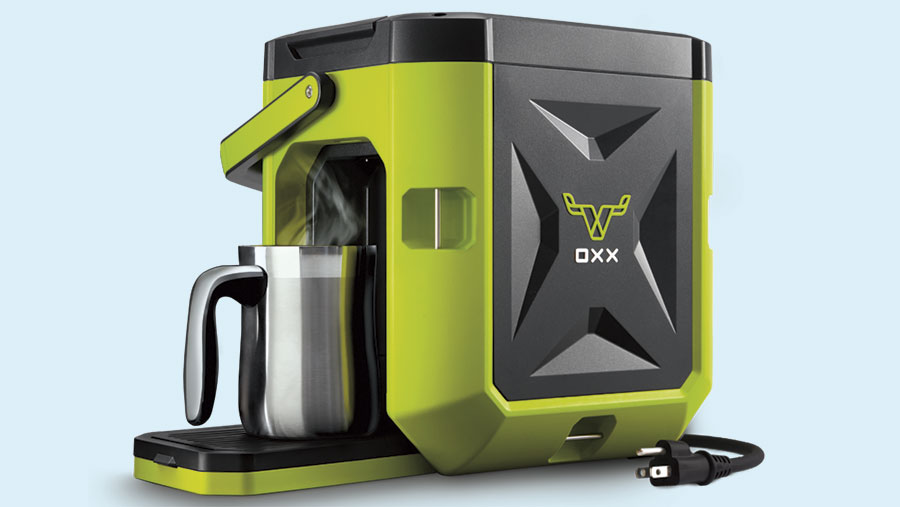
Each cycle takes just 90sec to make a cup using standard K-Cup coffee pods and its 2.5-litre water tank will keep you going through a long shift.
Unfortunately, it’s not available in the UK yet, but it’s surely only a matter of time. For US and Canadian customers, the Coffeeboxx costs US$230 (£171).
10. Chaff Deck
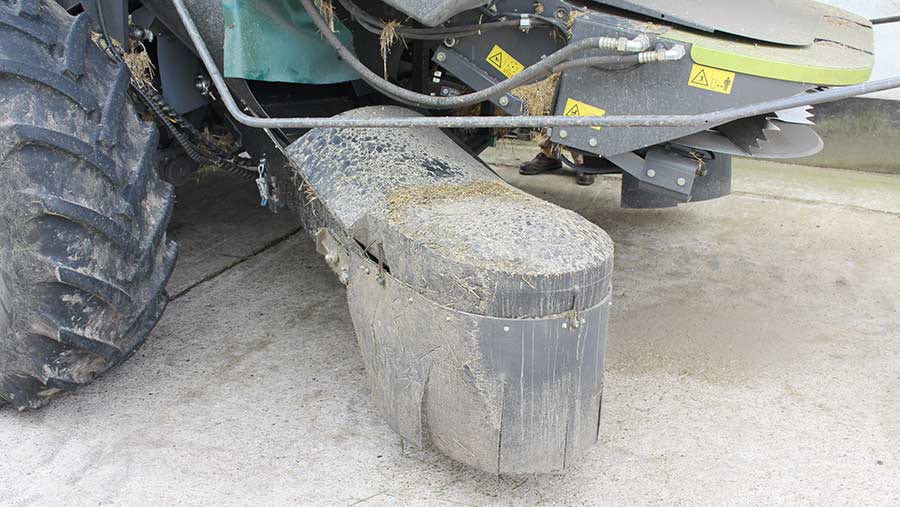
The Chaff Deck is an Australian invention designed primarily for controlled traffic farming (CTF) systems and bolts on the back of a combine, catching the chaff and weed seed before it hits the spreader.
The material is then placed on enclosed conveyor belts that distribute it behind the combine’s rear wheels. With tracks in CTF systems typically heavily compacted, it makes it a struggle for any grassweed seeds to get going.
The kit connects to the combine’s hydraulic circuit, but power demand is low so it is not thought to have had any effect on harvesting performance with John Deere, Case and New Holland machines in Australian conditions.
An AHDB-organised UK trial took place over the summer to see if the system – sold by Primary Sales Australia – might provide any value in the fight against blackgrass.
11. Chaff carts
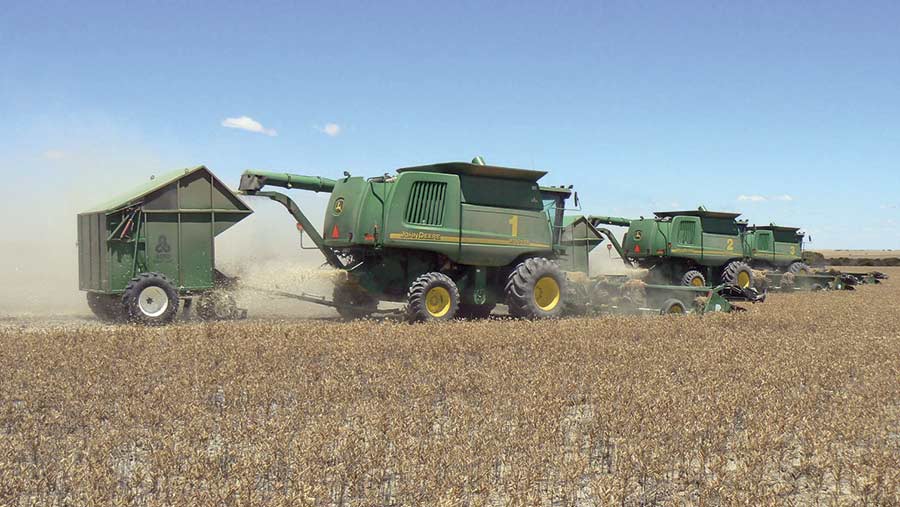
Across Australia it’s not unusual to see combines towing unusual trailer-type arrangements – chaff carts.
Designed specifically to capture weed and volunteer seeds before they’re spread out the back of the machine, chaff carts usually have an auger or conveyors that gather material off the back of the sieves and transfer it into the towed hopper.
Then at given intervals across the field the operator hits a button in the cab, which triggers the hydraulic tailgate or clamp-shell body to open, dumping the material in a heap.
With all the chaff dropped in the same place it forms a row, which can be burnt to destroy the unwanted seeds. (Some cautious cultivation around the heaps is usually undertaken as a fire precaution.)
12. Air Filter Blaster

Cleaning out air filters is always a bit of a hit and miss affair, which inevitably leads to spending the rest of the day covered in all the nasty stuff the engine didn’t want to breathe in.
But keeping filters clear is essential in maintaining engine performance and avoiding costly damage. Although many manufacturers recommend replacing rather than cleaning out filters, that’s rarely reality and could become quite a costly past-time.
Getting an even stream of air that reliably clears the entire filter without damaging the fine fibre or paper element is virtually impossible. To overcome this issue the Air Filter Blaster was developed in the US and is sold here by Chandlers Farm Equipment.
A four-jet rotating nozzle is spun by the flow of compressed air, uniformly blasting dust out of the filter from the inside out. It is mounted on an aluminium shaft that can slide up and down through the cap that is used to seal the end of the filter.
Available with 3in, 4.5in, 6in and 9in rotor heads, the Air Filter Blaster retails for £425.
13. Grain Saver/Rock Guard
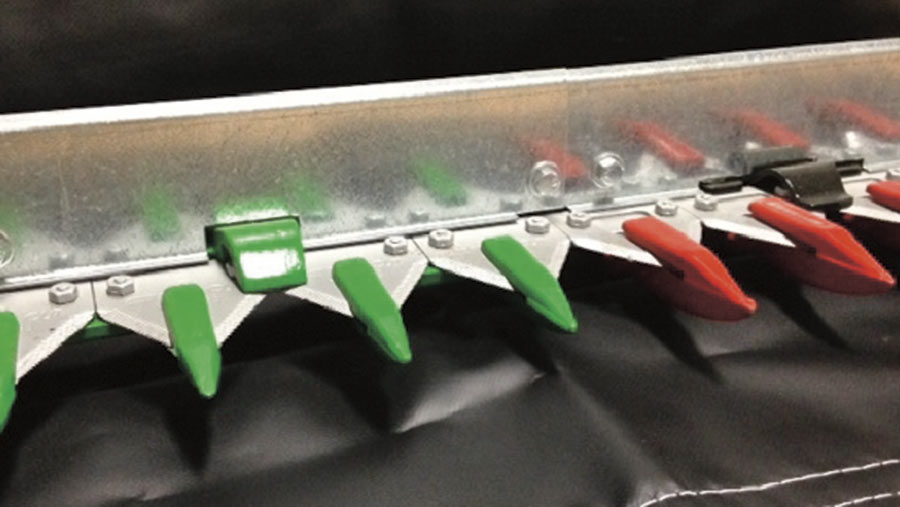
Based in Kentucky, father and son team William and Tim Johnson have developed a range of different products over the last 30 years designed to improve the performance of combines.
The Grain Saver/Rock Guard is a really simple device that was initially designed to help reduce header losses of soybeans but is now widely used across all crop types.
Effectively a 5cm-high strip of steel fixed behind the knife across the full width of the header, it forms a lip that stops loose grain falling forward off the table.
At the same time, it discourages stones, dirt and other foreign objects from flipping up over the cutterbar and entering the combine. Being sectional, it can flex with the knife and is reckoned to take about 5min to fit per foot of header width. It costs $25 (£19) per foot.
14. Elevator Debris Deflector
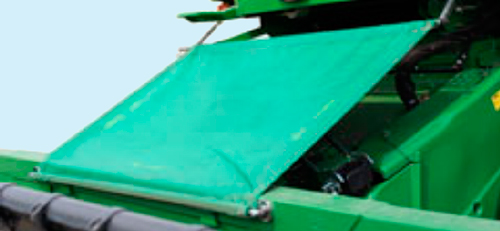
The Debris Deflector is a simple tarpaulin that forms a diagonal panel to keep the top of the elevator trunking clear of debris, channeling it straight back down onto the table when it is thrown upwards by the header auger.
Held in place by two large magnets, it’s easy to detach to remove the header or to clean the cab windows. It is priced at $349 (£259).
15. Feeder housing Dust Diverter
Designed to help keep the intake elevator area clear of debris as well as reducing the amount of dust thrown up onto the windscreen, the Dust Diverter mounts on the top of the feeder housing and sends a constant blast of air downwards to send material onto the ground.
Powered hydraulically, it is reckoned to take 30min to fit and costs $1,799 (£1,333).
16. Stationary counter-knives for older straw choppers
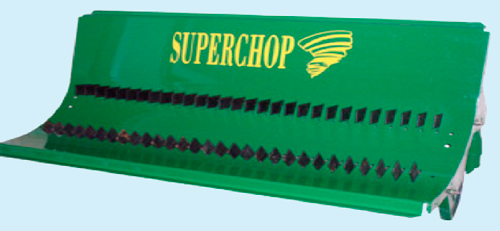
Older straw choppers don’t always do the best job of shredding and distributing material but a simple change can alter that. The Johnsons have developed a replacement hood that, like modern chopper units, has fixed counter-knives to retain material against the swinging chopper blades.
This bolt-on extra is said to help chop green stems and improve spread uniformity across the stubble. Suitable for various John Deere combines, it costs between $1,795 (£1,330) and $1,995 (£1,478).

